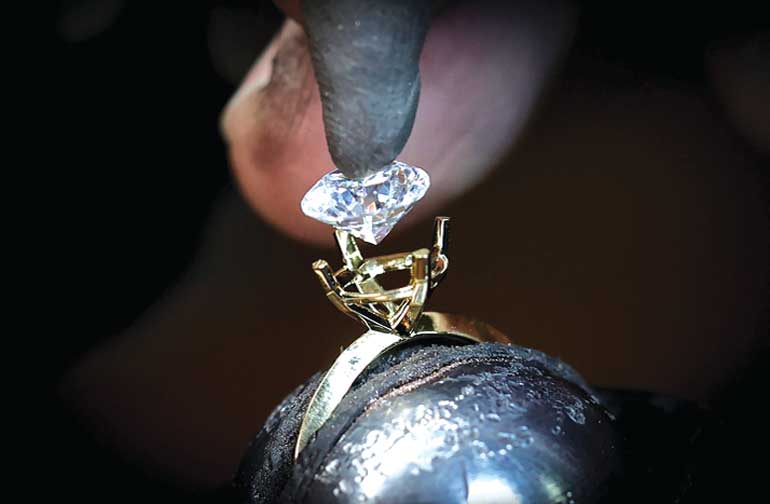Sunday Dec 14, 2025
Sunday Dec 14, 2025
Tuesday, 5 October 2021 00:46 - - {{hitsCtrl.values.hits}}

A worker sets an Aether diamond made from captured CO2 into a ring at the RFG Manufacturing Riviera jewelry design facility - Reuters
Reuters: What do diamonds, sunglasses, high-end lululemon sportswear and concrete have to do with climate change?
They can all be made using carbon dioxide (CO2), locking up the planet warming gas. And tech startups behind these transformations are grabbing investor attention.
Some use bacteria. Some use proteins. Some use chemical processes to speed natural reactions. Most pull apart the carbon and the oxygen in CO2 to create another chemical that is used to make consumers goods.
Companies in the area raised over $800 million so far this year, more than tripling from 2020, according to a Reuters review of data from PitchBook, Circular Carbon Network, Cleantech Group and Climate Tech VC.
“I don’t want to call it a green tax, but our consumers who really do care … have demonstrated that they’re willing to pay a bit of a premium,” said Ryan Shearman, Chief Executive of Aether Diamonds, which grows diamonds in the lab using captured CO2.
On the opposite end of the glamour spectrum, the concrete industry, green also is good for marketing, said Robert Niven, CEO of CarbonCure Technologies, which makes technology that injects CO2 into fresh concrete, and strengthens it by locking in the carbon.
“About 90% of our uptake has been from independent concrete producers large and small that are just looking for that competitive edge.”
The world needs to capture and store 10 billion tonnes of CO2 annually by mid-century to slow climate change, according to United Nations estimates, a scale the companies can only dream of, when current carbon capture pilots often are at scales of hundreds and thousands of tonnes.
Humans produce greenhouse gases that are the equivalent of around 50 billion tonnes of CO2 each year, and governments will gather in Scotland in late October and November for a UN climate conference on cutting emissions.
All fossil-based products that could use recycled CO2 instead account for some 6.8 billion tonnes of emissions, according to a Columbia University report in May, although lead author Amar Bhardwaj said trying to swap out all of that “would be a misuse of CO2 recycling,” since there are cheaper ways to reduce carbon emissions.
Nicholas Flanders, co-founder of Twelve, which uses chemical processes to reuse CO2, says recycling is better than storing captured CO2 underground. “We’re developing a technology that can go toe to toe with fossil fuels” without additional financial incentives to remove carbon.
That is because many consumers are attracted by “green” labels.
lululemon athletica inc says it has created a polyester yarn from carbon emissions with LanzaTech that will be used for future products. LanzaTech, which has raised the most funds of companies in the space, according to Reuters’ review, creates ethanol using bacteria.
Ethanol is turned into ethylene which is used to make everything from plastic bottles to polyester.
CEO Jennifer Holmgren said LanzaTech’s ethanol is more expensive than corn based ethanol, but customers looking to source greener products are buying.
The biggest investment in the space this year, more than $350 million, was into Houston-based Solugen, which feeds CO2 and other ingredients to enzymes that make chemicals for stronger cement, water pipe coating and other products.
Its products are already cheaper than those made from fossil fuels, said CEO Gaurab Chakrabarti. Still, it is not sourcing CO2 captured from factory emissions or from the air, which Chakrabarti described as “an option.”
Capturing CO2 is a less enticing prospect for many investors, who think the government should fund such expensive, high risk projects.
However, Nicholas Moore Eisenberger, managing partner at Pure Energy Partners, has invested in direct air capture firm Global Thermostat and sees opportunity in necessity and believes once the projects scale up, they will be cheaper.
“The science tells us that we have under a decade to start to bend the curve on climate, and that is now within the investment time frame of most venture and private equity investors,” said Eisenberger.